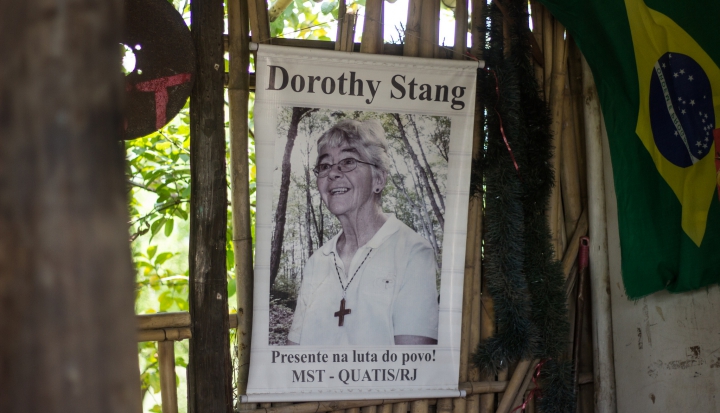I want to be like Sister Dorothy.
Dorothy Stang, a member of the Sisters of Notre Dame de Namur, was killed on February 12, 2005, by two unknown gunmen. She had spent years in Brazil resisting efforts to clear the Amazon, working on sustainable development projects with poor farmers against powerful interests. And she was evidently good at it.
Sister Dorothy was 73 when they killed her—73! And I have to wonder: What in this religious woman, this spiritual mother and grandmother, this sister to the poor and dispossessed, was so threatening that someone had to execute her? What about her merited such deadly attention?
She looked like so many other 73-year-old religious women: unassuming, hardly fashionable, barely distinguishable from the poor among whom she lived, yet with a twinkle in her eye, a bright smile, and a youthful face that hid her years. Still, there was probably little about her that would draw our notice, like the suffering servant of whom Isaiah spoke, a prophecy again fulfilled in Sister Dorothy’s broken body as it lay lifeless on a dirt road.
But like Lady Wisdom in the Book of Proverbs she spoke with insight, with truth, and put her words into action. Her work frightened some people, threatened them terribly. They didn’t just kill her; two men shot her six times in the face and chest, at point-blank range! What about her required that she not only be killed, but destroyed?
I think I know. I think she let God’s grace shine through her so much that the reign of God was threatening to break through, that the poor were going to have good news proclaimed to them, that the oppressed were going to go free. In her, God was going to cast down the proud and lift up the lowly, just as Mary promised in her gospel song.
The dawn from on high was threatening to break upon some backwater in Brazil. And the kingdom of this world just couldn’t allow that, just couldn’t permit a single victory for God. It’s a slippery slope, after all. One prisoner goes free, and pretty soon all of them will want to.
She isn’t the first martyr for the cause, of course, and she won’t be the last. On the day of her murder a local ranch worker, Claudio Bronco, was executed in front of his wife and five children.
Indeed, Sister Dorothy has many sisters and brothers: four other American women—Sisters Dorothy Kazel, Ita Ford, Maura Clarke, laywoman Jean Donovan—raped and killed in El Salvador in 1980 because of their work with the poor; a housekeeper and her daughter—Elba and Maricet Ramos—killed nearly 10 years later because they worked for the wrong Jesuits, six of whom were killed with them; thousands of others, their names forgotten or never known, parents and grandparents ground down with their children by injustice of every sort, Jesus’ band of the forgotten and forsaken—the ones who stood by his cross, the ones who always end up sharing it.
Sometimes I get discouraged by our church, by our hunger for prestige and power, our refusal to step into the future, our insistence that we’re right and everyone else is wrong. Sometimes, in my comfort and safety, I’m ready to quit. And then comes Sister Dorothy: prophet and apostle, announcing God’s reign, bold in her witness, courageous in her death, reminding me of the gospel’s power—a message so strong it’s worth dying for. How I wish I could be like her.
It’s a wish I dare not speak; I’m too afraid of death, of pain, of the cross, of the men who killed her. They’re too powerful. They don’t follow the rules, and they always seem to win. They have the guns, after all, and the money.
But Sister Dorothy had power, too. She scared them, terrified them with the Good News. And she won. Her killers had to step out into the open, show their hand, reveal their injustice and cruelty. They testified for her, proved her truth. And her witness is even more powerful in death than in life.
I want to be like Sister Dorothy, even though it scares me to death. But I mean it, and I’ll pray it; God, make me like Sister Dorothy.
This article originally appeared in the May 2005 issue of U.S. Catholic.
Image: Flickr cc via Flavio Serafini













Add comment